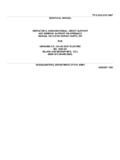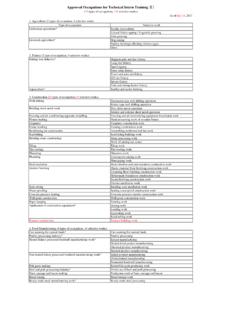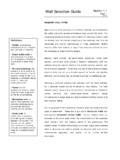Transcription of RAIL DEFECT MANUAL - milwaukeeroadarchives.com
1 rail DEFECT MANUAL Compiled by SPERRY rail SERVICE FOR THE USE OF THE RAILROADS ~ Michael Sol CollectionRAIL DEFECT MANUAL Compiled by SPERRY rail SERVICE FOR THE USE OF THE RAilROADS ~I Michael Sol CollectionCopyright 1964 SPERRY rail SERVICE A Division of Automation Industries, Inc. 1st Printing 6/64 2nd Printing 12/64 3rd Printing 8 /66 4th Printing 4 /68 CONTENTS Rails -History, Development and Early Use . Rails -Manufacturers & Mills (North America) rail -Special Treatments or Processes Basic Oxygen Steel For Rails.
2 Making Steel For Railroad Rails (Open Hearth) Control-Cooling of Rails -Description End Hardening of Rails -Description Fully Heat Treating Rails -Description Development of rail Testing Definition of Terms - rail Nomenclature Development of defects Transverse defects in the rail Head Transverse Fissures Compound Fissures . Detail Fracture from Shelling Detail Fracture from Head Check Engine Burn Fracture Welded Burn Fracture Longitudinal defects in the rail Head Horizontal Split Head Vertical Split Head Web defects Head & Web Separation Split Web.
3 Piped rail Base defects Broken Base Base Fracture Damaged rail . Square or Angular Break -Sudden Rupture Kinked rail Nicked rail Surface defects Shelling Flaking Slivers . Flowed rail Burned rail . Mill defects Crushed Head Corrosion Corrugation Miscellaneous defects Defective Weld . Detail Fracture from Welded Bond Connection Web defects in the J11int Area Bolt Hole Cracks . Head & Web Separations Sperry's rail Testing Services rail Breaking Programs 1 8 9 10 11 21 24 25 26 31 33 35 36 37 38 39 40 42 43 43 45 47 47 49 50 52 52 53 54 54 55 56 57 57 59 60 61 62 63 64 65 66 67 67 68 69 69 70 72 75 Michael Sol CollectionFOREWORD Sperry rail Service has compiled and published this fifth edition of the rail DEFECT MANUAL as a part of the technical service, in addition to actual rail testing, supplied to Sperry customers.
4 It is designed to benefit railroad tnen concerned with track safety and maintenance of the right-of-way. Since the publication and enthusiastic reception of the last edition of the rail DEFECT MANUAL in 1957 we have received many valuable and helpful suggestions from interested readers for the improvement of the MANUAL . Each of these suggestions has been given careful consideration and many of them have been incorporated in this new edition. The Sperry rail Service staff, working with railroad men throughout the country, has spared no effort to make this MANUAL a complete and accurate handbook of rail defects .
5 The material which it contains represents the findings of over 40 years of experience by Sperry rail Service in the field of rail testing. We realize that our interpretation of certain defects may not be in absolute accord with your own ideas and experience, and we invite your comments and suggestions. For easy reference this edition has been arranged according to th e location of each DEFECT in the rail . The various types of defects have been listed according to the classification system used by Sperry rail Service.
6 We thankfully acknowledge the section titled "Making Steel for Railroad rail " which was contributed by the Bethlehem Steel Co. and consists of excerpts from their Booklet 1822, "The Railroad rail ". We take this opportunity to thank all the railroad men who assisted us in the compilation of the DEFECT section of the MANUAL . We also thank the U. S. National Museum, Smithsonian In-stitution, for help in obtaining the historical data contained in this book. RAILS AND rail TESTING History of Rails The earliest record of the use of track for transportation comes from England, where, in 1604, a railway was constructed from nearby coal mines to the river Tyne.
7 The tracks were made of wooden rails, upon which wooden carts with flanged wheels were pushed by men or pulled by horses. During the eighteenth century, the growth of railways continued in the mining districts of England and Wales. As yet, the steam locomotive was unthought of. Horses or mules pulled the early trains. The tracks were originally made of pine or other soft wood. To improve the wearing quality, a top strip of hard wood was applied. During the middle period of the century, strips of malleable iron replaced the hard wood topping.
8 These iron strips were used only to provide a more durable wearing sur-face; the timber carried the weight and guided the wheels. first Metal rail In 1776 the first all-iron rail was manufactured near the city of Shef-field, England. These rails, called plate rail , (Fig. 1) were made of cast iron in sections 3 feet long. Since flanged-wheel carts were not common in the south of England nor in Wales, these rails were cast in shape of an L, the long leg of which rested on the roadbed while the short leg projected upward.
9 This construction permitted the use of either flanged or common cart wheels upon the track, the upthrust leg taking the place of the wheel flange in the latter case. Fig. 1. Plate rail . 3-feet long, made of cast iron, with an upward projecting flange to accommodate either cart or flanged wheels. Michael Sol Collection" Fig. 2. Edge rail , made of cast iron in 6-foot sections, for use with flanged wheels. In 1789 William Jessop, who later built the London-Croydon Railway, developed a new type known as edge rail (Fig.)
10 2). Due to its vertical section it was many times stronger than either strip or plate rail . In its earliest form, edge rail consisted of a thin web widening out at both head and base while the cross section above the supports closely re-sembled a modern rail section. first Public Railway In 1803 the first railroad intended for public use, the Surrey Iron Railway, was opened for operation between the London docks and Croy-den. Intended primarily as a public super-highway, the track was laid with flanged plate rail to accommodate cargo wagons or any other con-veyance whose owner was willing to pay for the privilege of a smooth fast ride on a hard road.







